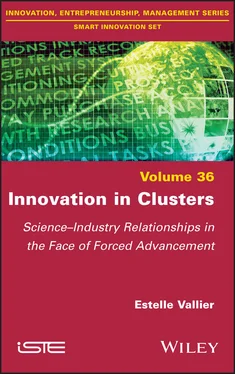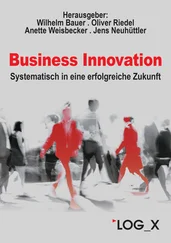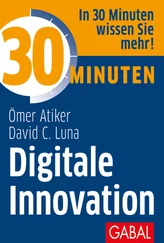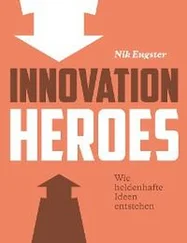Here, we see the concept of an environment that is “favorable” to innovation, where geographical proximity is a key factor in the interpenetration of the various neighboring structures. This intricacy enables the sharing of equipment and the circulation of individuals between structures. Underpinned by implicit knowledge sharing, it leads to innovations, which are formal and wealth-producing and which reinforce the attractiveness of the cluster.
I.1.3. Focusing on biotechnologies: catching up with the world through clustering
This book is particularly concerned with the contextualization and clustering of the life sciences. A major turning point for the life sciences occurred in the 1980s in the United States with the passage of the Bayh-Dole Act, which allowed universities to patent publicly funded research (Gaudilliere and Joly 2006). The patenting of life forms has thus played an important role in bringing together the life sciences and their technological application, commonly known as biotechnology. This is understood as “a set of procedures implementing biological knowledge for a transformation of the living body: gene therapy, cloning, genetic modification of organisms, etc.” (Keck 2003, p. 182). It is identified as a field with a high technological potential, capable of “irrigating large areas of the economy” (Branciard 2004, p. 10), its aim being to make living organisms a factor of production like any other. Since 1983, the Ministry of Research has notably been one of the institutions involved in promoting biotechnology through organizations such as the National Scientific Research Centre ( Centre national de la recherche scientifique , CNRS), the Atomic Energy Commission ( Commissariat à l’énergie atomique , CEA), the National Agronomic Research Institute ( Institut national de la recherche agronomique , INRA), the National Health and Medical Research Institute ( Institut national de la santé et de la recherche médicale , INSERM), universities, foundations, etc. In addition to the creation of a national committee on these issues (the “biotechnology boom” program) 13, the state committed itself to promoting biotechnology on October 17, 1990. Hubert Curien, Minister of Research at the time, launched the National Human Genome Program in the Council of Ministers (Guthleben and Faou 2011). The aim was to set up a coordinated strategy with all the laboratories and institutes already involved in biological research on the genome. The program also aims to coordinate cooperation with the United States around the Human Genome Project, which aims to establish complete DNA sequencing.
Biotechnology generally refers to health-related production processes, but in reality, it covers other industrial sectors, primarily biopharmaceuticals (therapeutic products, diagnostics, medical devices, etc.) and the biofood sector (Heil 2010, p. 240). The former comprises two types of actors: small innovative firms often originating from academia (spin-offs) which, in most cases, once the fundamental research has been completed, are bought out by “big pharma”, which takes over the costly processes of the clinical phase, production and marketing. The latter addresses human nutrition, agriculture and the environment (production of food based on microalgae, detection of plant pathogens, biorefining, detection of pollutants from modified living organisms, etc.).
Biotechnology assumes both a strong academic base and interaction with the medical and industrial worlds (pharmaceuticals, therapies, agrifood, agrochemicals, environment, bioenergy). It is therefore positioned between a world that guarantees diversity (academic research) and another whose challenges, conversely, relate to standardization (medical and/or industrial application) (Branciard 1999, p. 3).
In order to resolve this conflict between standardization and the maintenance of diversification, public action mechanisms create conditions for the coming together of laboratories, universities, companies and equipment in localized spaces (biotechnology clusters or bioclusters). The cost of equipment, in particular, would explain the need for agglomerated networks in the case of biotechnology, in order to pool vital, cutting-edge instruments (Aggeri et al . 2007b, p. 202). Finally, the dominant argument in the 1990s was that there was too great a gap between scientific production in the life sciences and its commercialization, which was reflected in an insufficient number of start-ups and patent applications. Particularly in the case of biotechnology, the rhetoric is as follows: “The articulation of science with industry is not self-evident: a forcing seems necessary” (Brunet 2011, p. 2). From then on, bringing together two worlds that ignore each other requires incentives and, in particular, the creation of an intermediation structure between science and industry.
I.2. The cooperation mechanism in a biocluster context: from concept to reality
Originating in the United States, the cluster concept has become a worldwide phenomenon. In France, it has been supported by public authorities through the creation of intermediation structures in charge of strengthening the relationship between science and industry.
I.2.1. The advent of structures for science and industry intermediation
The literature uses the term “hybrid organization” (Branciard 2009) or “hybrid organism” (Leydesdorff and Etzkowitz 2000) 14. Very quickly, within institutional vocabulary, the term “incubator” has become a cornerstone of science–industry rapprochement policies (Shinn 2002, p. 28). Nevertheless, among these different terms and, in a sociological approach, that of “public intermediation structure”, Brunet pertinently evokes the intervention of these structures between (“inter”) two quite distinct worlds (Brunet 2011), in order to facilitate arbitration intended to reconcile them (“mediation”) 15. Moreover, this name highlights the public character of these institutions.
These structures, which are generally financed by local and national governments, can be found in various forms (associations, mixed syndicates, mixed economy companies, etc.). Most were created in response to calls for projects from competitiveness clusters. However, some were created before, and in parallel with, these clusters. The latter are anchored in a regional framework, but there are other structures for which territoriality is defined on a conurbation or a department scale. Most operate with an accreditation policy to attract laboratories and companies. Once accreditation is obtained, the new member organization benefits from services offered by the cluster (preferential rents, access to specialized and shared equipment, a computer network, etc.). When local geographic clustering is carried out, most structures rely on the “total network” (Suire and Vicente 2014). The relational density between the three actors of science, industry and training, enabled by geographical proximity, is touted as a major condition for innovation. Nevertheless, many intermediation structures struggle to meet this objective and find themselves confronted with the following organizational difficulty: how to create cooperation when it does not occur spontaneously through geographical proximity. This question echoes sociological literature, which highlights the absence of spontaneous links between spatial proximity and social interaction, notably in the study of the politics of large urban areas (Chamboredon and Lemaire 1970). Work on clusters also emphasizes the relationship or otherwise between, for instance, geographic, organized and cognitive proximity (Talbot and Kirat 2005; Bouba-Olga and Grossetti 2010; Torre and Zuindeau 2012).
Читать дальше












